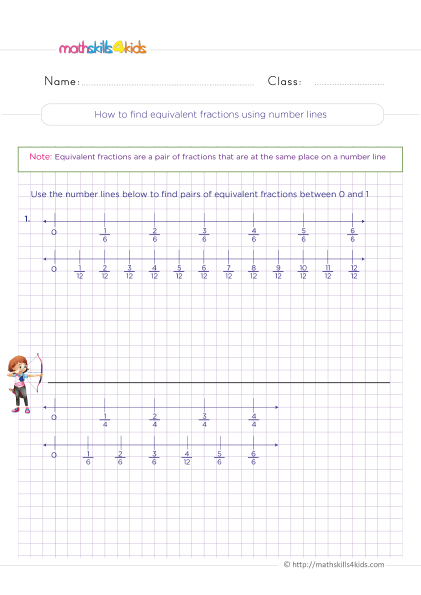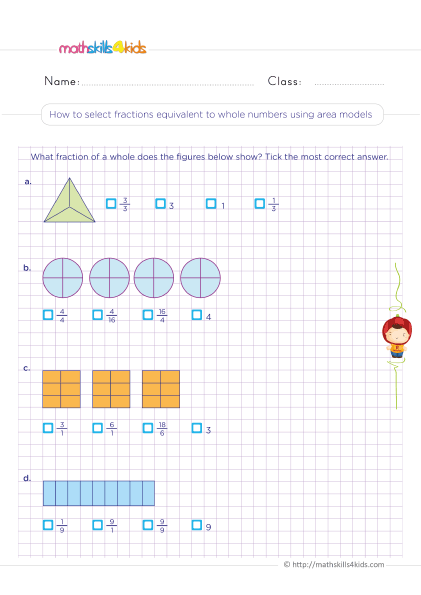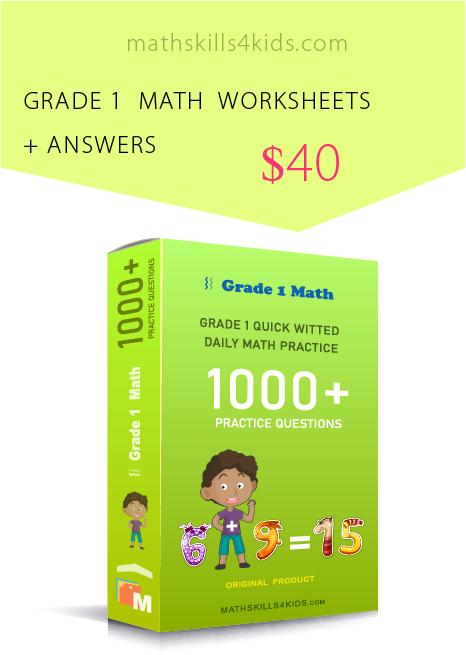Equivalent fraction worksheets for 3rd Grade: Printable and free
Hi there! Welcome to this amazing article, where we share tips and resources to help you and your kids learn math in a fun and easy way. Today, we’ll discuss one of the most essential topics in third-grade math: equivalent fractions. So, if you're looking for printable and free equivalent fraction worksheets for 3rd Grade, you've come to the right place!
But before we get to the worksheets, let's review what equivalent fractions are and why they are important.
-
What are equivalent fractions, and why are they important?
Equivalent fractions have the same value, even though they may look different. For example, 1/2 and 2/4 are equivalent fractions because they represent half of a whole. To find equivalent fractions, multiply or divide the numerator and the denominator by the same number (except zero). For example, to find an equivalent fraction for 3/5, multiply 3 and 5 by 2 to get 6/10.
Equivalent fractions are important because they help us compare and simplify fractions. When we compare fractions, we need to find a common denominator (the bottom number) to see which fraction is larger or smaller. For example, to compare 2/3 and 3/4, we can find equivalent fractions with a common denominator of 12: 8/12 and 9/12. Then we can see that 3/4 is larger than 2/3 because 9/12 is larger than 8/12.
When simplifying fractions, we find an equivalent fraction with the smallest possible numerator and denominator. This is called the lowest term or simplest form of a fraction. For example, to simplify 6/9, we can divide 6 and 9 by 3 to get 2/3. This is the lowest term of 6/9 because no other number can divide 2 and 3 evenly.
-
BROWSE THE WEBSITE
-
DOWNLOAD FREE WORKSHEETS
-
-
3rd GRADE MATH TOPICS
- Number and compapring
- Place value
- Addition
- Subtraction
- Understand multiplication
- Multiplication skill builders
- Multiplication fluency
- Multiplication
- Understand division
- Division skill builders
- Division fluency
- Division practice
- Mixed operation
- Properties
- Equations & variations
- Estimate & rounding
- Logical reasoning
- Patterns
- Money
- Telling time
- Data graph & probability
- Understanding fractions
- Equivalent fractions
- Comparing and ordering fractions
- Operations with fractions
- Unit of measurement
- Two-dimensional shapes
- Triangles and quadrilaterals
- 3D shapes
- Geometric measurement
-
-
How to find equivalent fractions using area models
 Print it...
Print it...
-
How to find equivalent fractions using number line
 Print it...
Print it...
-
Identifying equivalent fractions
 Print it...
Print it...
-
How do you use an area model to find equivalent fractions?
 Print it...
Print it...
-
How to find equivalent fractions with denominators of 10 and 100
 Print it...
Print it...
-
How to write fractions in lowest terms
 Print it...
Print it...
-
How to find equivalent fractions using area models
-
Buying is supporting us!
Buy Now...
-
-
How to use visual models to compare and simplify equivalent fractions
One of the best ways to help your kids understand equivalent fractions is to use visual models such as fraction strips, fraction circles, area models, or number lines. One trusted website where you can find these visual models for solving equivalent fractions problems is Mathskills4kids.com. However, let’s find out how to use these visual models to compare and simplify equivalent fractions.
These visual models help your kids see how different fractions can represent the same part of a whole. Also, they help your kids see how to compare and simplify fractions by finding common denominators or dividing by common factors.
For example,
Using fraction strips, you can show your kids how 1/2 and 2/4 are equivalent by placing them on top of each other. You can also show them how to compare 2/3 and 3/4 by finding equivalent fractions with a common denominator of 12: 8/12 and 9/12. You can then place these fraction strips side-by-side and see which is longer or shorter.
Using fraction circles, you can show your kids how to simplify fractions by finding the largest common factor that can divide the numerator and the denominator. For example, to simplify 6/9, you can show them how to divide the numerator and the denominator by 3 using fraction circles. You can then show them the simplified fraction (2/3) on a fraction circle.
Using area models, you can show your kids how to find equivalent fractions by multiplying or dividing the numerator and the denominator by the same number. For example, to find an equivalent fraction for 3/5, you can show them how to multiply 3 and 5 by 2 using an area model. You can then show them the equivalent fraction (6/10) on an area model.
Using number lines, you can show your kids how to identify equivalent fractions by locating them on the same point on a number line. For example, to identify equivalent fractions for 1/2, you can show them how to locate different fractions that have the same value as 1/2 on a number line. You can then show them how these fractions (2/4, 3/6, or 4/8) are equivalent to 1/2.
-
Fun and engaging activities to practice equivalent fractions with your kids
Besides visual models, you can also use fun and engaging activities to practice equivalent fractions with your kids. Here are some ideas:
- Play a matching game with cards that have different fractions on them. The goal is to find pairs of cards that have equivalent fractions. You can make cards or use free printable cards from Math Geek Mama.
- Make a fraction wall with paper strips with different fractions. The goal is to arrange the strips on a wall or a board to show how fractions are equivalent. You can make or use these free printable strips from Math Salamanders.
- Play a bingo game with boards that have different fractions on them. The goal is to mark off fractions equivalent to the ones called out by the bingo caller. You can make your boards or use these free printable boards from Teachers Pay Teachers.
- Make a fraction pizza with paper plates and toppings with different fractions. The goal is to cut the pizza into slices that have equivalent fractions. You can make your plates and toppings or use these free printable plates and toppings from Dixie Paper Plate Pizzas!
- Play a dominoes game with tiles that have different fractions on them. The goal is to match the tiles by finding equivalent fractions. You can make your tiles or use these free printable tiles from Math Salamanders.
-
Enjoy MathSkills4Kids free printable equivalent fraction worksheets for 3rd-grade
One of the best ways to help your child learn and practice equivalent fractions is using our free printable worksheets. These MathSkills4Kids free printable equivalent fraction worksheets for 3rd Grade are designed to provide your child with various exercises and challenges that will reinforce their understanding of equivalent fractions and help them develop their math skills.
Our worksheets cover different topics related to equivalent fractions, such as:
- How to find equivalent fractions using area models: This worksheet will help your child visualize how shaded regions of a shape can represent fractions and how different fractions can have the same area.
- Identifying equivalent fractions on a number line: This worksheet will help your child see how fractions can be located on a number line and how different fractions can have the same position.
- Finding equivalent fractions using number lines: This worksheet will help your child use number lines to find equivalent fractions by dividing or multiplying the numerator and denominator by the same number.
- Graphing equivalent fractions on number lines: This worksheet will help your child use number lines to graph equivalent fractions by finding common denominators and comparing numerators.
- Finding equivalent fractions with missing numerators and denominators: This worksheet will help your child use cross-multiplication to find the missing values in equivalent fractions.
- How to select fractions equivalent to whole numbers using area models: This worksheet will help your child understand how fractions can be equivalent to whole numbers by using area models and finding common factors.
- How to find fractions equivalent to whole numbers: This worksheet will help your child use division and multiplication to find fractions equal to whole numbers.
- How to find equivalent fractions with denominators of 10 and 100: This worksheet will help your child use place value and decimal notation to find equivalent fractions with denominators of 10 and 100.
- How to write fractions in the lowest terms: This worksheet will help your child simplify fractions by finding the greatest common factor of the numerator and denominator and dividing both by it.
You can download these worksheets for free from our website and print them out for your child to work on at home or in the classroom. You can also check the answers online or download the answer keys for each worksheet.
We hope you enjoy these worksheets and find them useful for your child's math education!
-
Tips and tricks to help your child master equivalent fractions
Equivalent fractions can be tricky to learn, but with some practice and patience, your child can master this important math skill. Here are some tips and tricks to help your child along the way of mastering equivalent fractions:
- Review the basics of fractions. Ensure your child understands a fraction, how to read and write fractions, and how to compare fractions with the same denominator. You can use visual models, such as fraction bars, circles, or squares, to show your child how fractions represent parts of a whole.
- Explain the concept of equivalent fractions. Tell your child that equivalent fractions have the same value, even though they look different. For example, 1/2 and 2/4 are equivalent fractions because they represent half of a whole.
You can use visual models to show your child how equivalent fractions have the same size and shape, even though they have different numbers.
- Teach your child how to find equivalent fractions using multiplication and division. Show your child how to multiply or divide a fraction’s numerator and denominator by the same number to get an equivalent fraction.
For example, to find an equivalent fraction for 2/3, multiply 2 and 3 by 2 to get 4/6. You can also divide both 2 and 3 by 2 to get 1/1.5. You can use visual models to show your child how multiplying or dividing by the same number does not change the size or shape of the fraction, only the numbers.
- Practice finding equivalent fractions using different methods. You can use worksheets, games, puzzles, or online tools to help your child practice finding equivalent fractions using different methods.
For example, you can use area models, number lines, cross-multiplication, or simplifying fractions. Using different strategies, you can mix the methods and challenge your child to find equivalent fractions.
- Check your child's understanding of equivalent fractions. You can use quizzes, tests, or word problems to assess your child's understanding of equivalent fractions. You can also ask your child to explain how they found an equivalent fraction or why two fractions are equivalent. You can also ask your child to find errors or mistakes in finding equivalent fractions and correct them.
-
Applying equivalent fractions in real-life situations
Equivalent fractions are not only useful in math class but also in real-life situations. Here are some examples of how you can apply equivalent fractions in everyday life:
- Cooking and baking. When you follow a recipe, you often need to measure ingredients using fractions. Sometimes, you may not have the exact measuring cup or spoon needed, so you can use equivalent fractions to measure correctly.
For example, if you need 1/4 cup of sugar but only have a 1/3 cup measure, you can use an equivalent fraction of 3/4 of the 1/3 cup measure to get 1/4 cup of sugar.
- Shopping and budgeting. When you shop for groceries or other items, you may encounter discounts or sales that use fractions. You may also need to compare prices or quantities using fractions.
For example, if you want to buy a pack of 12 pencils that costs $3.60, but there is a sale for 25% off, you can use an equivalent fraction of 3/4 to find the discounted price. You can multiply $3.60 by 3/4 to get $2.70 as the final price.
- Time and scheduling. When you plan your day or week, you may use fractions to divide your time into different activities or tasks. You may also need to convert between different units of time using fractions.
For example, if you have an appointment at 10:30 am but need to leave your house at least half an hour before, you can use an equivalent fraction of 1/2 to find what time you need to leave. You can subtract 1/2 hour from 10:30 am to get 10:00 am as the time you need to leave.
Equivalent fractions are a fun and useful math skill your child can learn and apply in many ways. With MathSkills4Kids free printable equivalent fraction worksheets for 3rd grade, you can help your child practice and master this skill in a fun and engaging way.
Download and print them today and enjoy learning math with your child!
- Cooking and baking. When you follow a recipe, you often need to measure ingredients using fractions. Sometimes, you may not have the exact measuring cup or spoon needed, so you can use equivalent fractions to measure correctly.
Bonus: Find more resources to reinforce equivalent fraction learning in Third Grade here!
If you are looking for more resources, activities, and free printable equivalent fraction worksheets for 3rd Graders to reinforce their equivalent fractions learning skills, you are in luck! We have compiled a list of some amazing online resources you can use with your students or share with their parents.
These resources include games, worksheets, videos, and interactive activities that make learning equivalent fractions a memorable experience!
Here are some of the resources that we recommend:
- 6 Activities to Practice Equivalent Fractions in Third Grade by Jillian Starr: This blog post has six awesome ideas for using fraction strips, dice, dominoes, legos, puzzles, and bingo to teach equivalent fractions. You can find the post and the free printables here: https://jillianstarrteaching.com/equivalent-fractions/
- Equivalent Fractions 3rd Grade Resources, Worksheets, and Activities by Mashup Math: This website has five free activities for exploring equivalent fractions, including fraction strips, fraction circles, legos, and worksheets.
You can access the activities and the answer keys here: https://www.mashupmath.com/blog/equivalent-fractions-3rd-grade.
- Equivalent Fractions for Google Classroom by Glitter in Third: This product includes eight different activities compatible with Google Classroom.
Students will practice matching or identifying fractions equal to 1, ½, ⅓, and ¼ by completing short answer and drag-and-drop questions. You can purchase the product here: https://glitterinthird.com/2020/12/teaching-equivalent-fractions-activities.html.
-
Thank you for sharing the links of MathSkills4Kids.com with your loved ones. Your choice is greatly appreciated.
Before concluding, we hope you enjoyed this article about equivalent fraction worksheets for 3rd grade.
Equivalent fractions are an important concept that students need to understand and apply in various situations. Using Mathskills4kids’ visual models, fun activities, and practice worksheets, you can help students develop a solid foundation in equivalent fractions.
Thank you for reading, and happy teaching!
